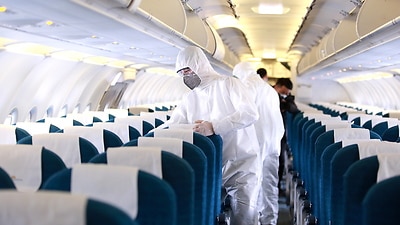COVID-19 Update from IATA
The International Air Transport Association (IATA) announced global passenger traffic data for January 2020 showing that demand (measured in total revenue passenger kilometers or RPKs) climbed 2.4% compared to January 2019. This was down from 4.6% year-over-year growth for the prior month and is the lowest monthly increase since April 2010, at the time of the volcanic ash cloud crisis in Europe that led to massive airspace closures and flight cancellations. January capacity (available seat kilometers or ASKs) increased by 1.7%. Load factor climbed 0.6 percentage point to 80.3%.
“January was just the tip of the iceberg in terms of the traffic impacts we are seeing owing to the COVID-19 outbreak, given that major travel restrictions in China did not begin until 23 January. Nevertheless, it was still enough to cause our slowest traffic growth in nearly a decade,” said Alexandre de Juniac, IATA’s Director General and CEO.
Air passenger market detail – January 2020
| World
share 1 |
January 2020 (% year-on-year)
RPK |
ASK PLF (%-pt)2 |
PLF (level)3 |
||
| TOTAL MARKET | 100.0% | 2.4% | 1.7% | 0.6% | 80.3% |
| Africa | 2.1% | 5.2% | 6.1% | -0.6% | 70.2% |
| Asia Pacific | 34.7% | 0.4% | 2.2% | -1.5% | 79.9% |
| Europe | 26.8% | 1.6% | -0.5% | 1.7% | 81.6% |
| Latin America | 5.1% | 0.4% | 0.0% | 0.3% | 82.6% |
| Middle East | 9.0% | 5.9% | 0.6% | 3.9% | 78.5% |
| North America | 22.2% | 5.7% | 3.6% | 1.6% | 81.2% |
1% of industry RPKs in 2019 2Year-on-year change in load factor 3Load factor level
4 Note: the seven domestic passenger markets for which broken-down data are available account for 30% of global total RPKs and approximately 83% of total domestic RPKs
International Passenger Markets
January international passenger demand rose 2.5% compared to January 2019, down from 3.7% growth the previous month. With the exception of Latin America, all regions recorded increases, led by airlines in Africa and the Middle East that saw minimal impact from the COVID-19 outbreak in January. Capacity climbed 0.9%, and load factor rose 1.2 percentage points to 81.1%.
Asia-Pacific airlines’ January traffic climbed 2.5% compared to the year-ago period, which was the slowest outcome since early 2013 and a decline from the 3.9% increase in December. Softer GDP growth in several of the region’s key economies was compounded by COVID-19 impacts on the international China market. Capacity rose 3.0% and load factor slid 0.4 percentage point to 81.6%.
European carriers saw January demand climb just 1.6% year-to-year, down from 2.7% in December. Results were impacted by slumping GDP growth in leading economies during the 2019 fourth quarter plus flight cancellations related to COVID-19 in late January. Capacity fell 1.0%, and load factor lifted 2.1 percentage points to 82.7%.
Middle Eastern airlines posted a 5.4% traffic increase in January, the fourth consecutive month of solid demand growth, reflecting strong performance from larger Europe-Middle East and Middle East-Asia routes, which were not significantly impacted by route cancellations related to COVID-19 at that time. Capacity increased just 0.5%, with load factor jumping 3.6 percentage points to 78.3%.
North American carriers’ international demand rose 2.9% compared to January a year ago, which represented a slowdown from the 5.2% growth recorded in December, although there were no significant flight cancellations to Asia in January. Capacity climbed 1.6%, and load factor grew by 1.0 percentage point to 81.7%.
Latin American airlines experienced a 3.7% demand drop in January compared to the same month last year, which was a further deterioration compared to a 1.3% decline in December. Traffic for Latin American carriers has now been particularly weak for four consecutive months, reflecting continued social unrest and economic difficulties in a number of countries in the region unrelated to COVID-19. Capacity fell 4.0% and load factor edged up 0.2 percentage point to 82.7%.
African airlines’ traffic climbed 5.3% in January, up slightly from 5.1% growth in December. Capacity rose 5.7%, however, and load factor slipped 0.3 percentage point to 70.5%.
Domestic Passenger Markets
Demand for domestic travel climbed 2.3% in January compared to January 2019, as strong growth in the US helped mitigate the impact from a steep decline in China’s domestic traffic. Capacity rose 3.0% and load factor dipped 0.5 percentage point to 78.9%.
Air passenger market detail – January 2020
| World
share 1 |
January 2020 (% year-on-year)
RPK |
ASK PLF (%-pt)2 |
PLF (level)3 |
| Domestic | 36.2% | 2.3% | 3.0% | -0.5% | 78.9% |
| Dom. Australia4 | 0.8% | 0.1% | -1.4% | 1.2% | 79.3% |
| Domestic Brazil4 | 1.1% | 2.1% | 0.1% | 1.6% | 85.7% |
| Dom. China P.R.4 | 9.8% | -6.8% | -0.2% | -5.4% | 76.7% |
| Domestic India4 | 1.6% | 2.5% | 2.3% | 0.1% | 86.1% |
| Domestic Japan4 | 1.1% | 3.8% | 1.9% | 1.3% | 68.1% |
| Dom. Russian Fed.4 | 1.5% | 3.9% | 8.3% | -3.1% | 72.2% |
| Domestic US4 | 14.0% | 7.5% | 4.9% | 1.9% | 81.1% |
1% of industry RPKs in 2019 2Year-on-year change in load factor 3Load factor level
4 Note: the seven domestic passenger markets for which broken-down data are available account for 30% of global total RPKs and approximately 83% of total domestic RPKs
Chinese airlines’ domestic traffic fell 6.8% in January, reflecting the impact of flight cancellations and travel restrictions related to COVID-19. China’s Ministry of Transport reported an 80% annual fall in volumes in late January and early February. Capacity slipped 0.2% and passenger load factor plunged 5.4 percentage points to 76.7%.
US airlines saw domestic traffic climb 7.5% in January. Although this was down from 10.1% growth in December, it represented another strong month of demand growth reflecting supportive business confidence and domestic economic outcomes at the time. Capacity rose 4.9% and load factor climbed 1.9 percentage points to 81.1%.
The Bottom Line
“The COVID-19 outbreak is a global crisis that is testing the resilience not only of the airline industry but of the global economy. Airlines are experiencing double-digit declines in demand, and on many routes traffic has collapsed. Aircraft are being parked and employees are being asked to take unpaid leave. In this emergency, governments need to consider the maintenance of air transport links in their response. Suspension of the 80/20 slot use rule, and relief on airport fees at airports where demand has disappeared are two important steps that can help ensure that airlines are positioned to provide support during the crisis and eventually in the recovery,” said de Juniac.
Watch Live Stream & Real Time Statistics of COVID-19
Other COVID-19 Updates
Tiger Tests Positive for Coronavirus at New York Zoo
Harvard Talks: Cut Salaries or Cut People?
Lamborghini Medical Shields & Surgical Masks for Health Workers
WHO COVID-19 Buildings & Tents Screening Layout Standards
UCLA Engineer Made a Ventilator from Hardware Items
Airbus Gives 3D-Printed Hospital Visors to Health Workers
Airlines COVID-19 Analysis: Aviation Collapsed
Forecast Deaths, Hospitals & Ventilators: COVID-19 Impact, USA Full Report
Ventilation Standards for Buildings Converted to COVID-19 Hospitals
Harvard Talks: The Supply Chain in Post COVID-19 Era
COVID-19 Deaths to Reach 81,000 in US By June – Forecasts by IHME & Univ. of Washington
Top 10 Largest Ventilator Manufacturers in the World
List of Government Officials Tested Positive in PH
Metronic Ventilator Ramping Up Production
Engineers, Can You Help Build a DIY Ventilator for Hospitals?
Water is Our First Line of Defense Against COVID-19
COVID-19 Economic Aftermath on the Construction Industry
Complete List of Companies Working on Coronavirus Vaccine
COVID-19 War: 70K Physicians vs 109M Filipinos
Famous People Who Have Tested Positive for COVID-19
These Politicians Tested Positive for Coronavirus (COVID-19)
Postponed Exhibitions in the Philippines due to COVID-19
Cancelled Major Events Around the World Due to COVID-19
World Bank Gives $12 Billion to COVID-19 Affected Countries
COVID-19 Philippines: DOH on Code Red Status
PPE Shortage Endangering Health Workers Worldwide
The List of COVID-19 Disinfectants Approved by EPA
World Bank Gives $12 Billion to COVID-19 Affected Countries
Air Cargo Demand Down 3.3% due to COVID-19 Disruption





















